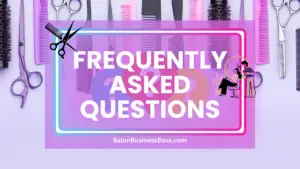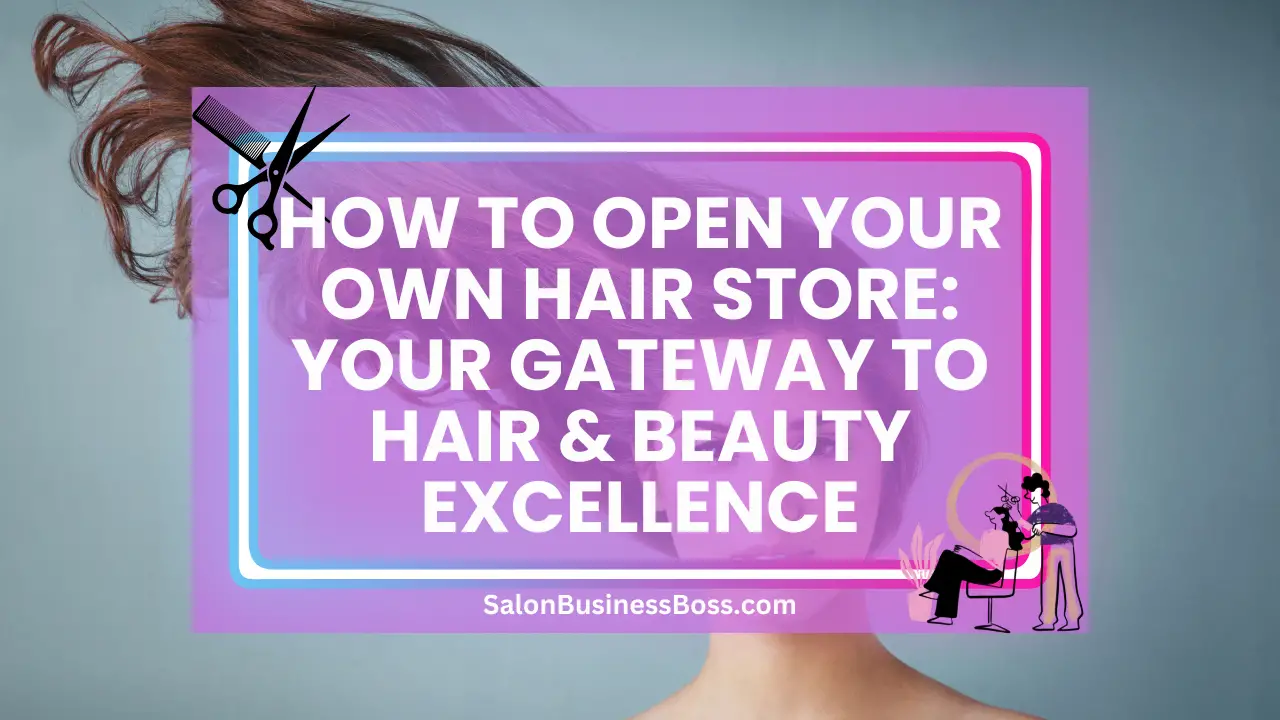Opening your own hair store can be an exciting venture that allows you to turn your passion for hair and beauty into a profitable business. A hair store offers a wide range of products, from hair extensions and wigs to hair care products and accessories. However, starting a hair store requires careful planning, market research, and a deep understanding of the industry.
To open your own hair store, conduct thorough market research, choose a strategic location, and source top-quality hair products. Create an inviting store layout, build an online presence, and prioritize excellent customer service. Stay updated on industry trends and implement effective marketing strategies to attract a loyal customer base.
1. Market Research and Business Plan

Conducting comprehensive market research is a foundational step before venturing into the world of entrepreneurship with your hair store. This process involves delving into the intricacies of the hair and beauty industry to gain valuable insights. Identify your target audience, understanding their needs, preferences, and purchasing behavior. Thoroughly assess your competition, including other hair stores and beauty retailers, to discern gaps in the market that you can capitalize on.
Staying updated on the latest trends in hair and beauty is crucial to remain relevant and meet customer demands effectively. Analyze the local market’s size and potential to gauge the viability of your hair store’s success in that area.
With valuable data in hand, craft a detailed business plan that will serve as your roadmap to success. Your business plan should encompass your store’s vision and mission, outlining the unique value proposition you bring to customers. Lay out your marketing strategies, encompassing both online and offline tactics, to reach and engage your target audience effectively.
Pricing strategies are also a pivotal aspect of your business plan, as competitive pricing can be a differentiating factor. Finally, your financial projections should be realistic, outlining anticipated costs, revenue, and potential profits over a specific timeline. An accurate business plan provides direction and helps secure financing from investors or lenders for your hair store.
Read more about: How to Open a Hair Salon: From Vision to Grand Opening
2. Choose a Suitable Location
The location you choose for your hair store can make or break its success. A high-traffic area with significant footfall and visibility is vital to attract potential customers and create brand awareness. Consider spaces near beauty salons, shopping centers, or fashion districts, as these locations naturally draw individuals interested in hair and beauty products.
Assess the accessibility of the location, ensuring it is easy for customers to reach. Ample parking facilities or proximity to public transportation can significantly enhance the convenience factor for your clientele.
When negotiating lease terms, carefully review the contract, seeking flexibility and favorable conditions. Aligning the location with your target market’s demographics is essential to maximize sales potential. Moreover, ensure that the location fits within your budget constraints, as high-rent areas may lead to financial strain for a new business.
By thoughtfully selecting the right location, your hair store gains a competitive edge, increased foot traffic, and heightened visibility, setting the stage for a successful and thriving retail venture.
3. Legal Requirements and Registration
Setting up a legal entity for your hair store is essential to protect your personal assets and establish credibility. Choosing the right business structure, such as a sole proprietorship, partnership, LLC, or corporation, depends on factors like liability, taxation, and management structure. Each structure has its advantages and disadvantages, so it’s crucial to understand them and select the one that aligns with your business goals and risk tolerance.
Registering your business with the appropriate authorities is a critical step in the process. This typically involves obtaining a business license or permit from your local government. Depending on your location and the nature of your hair store, you might also need additional permits related to health and safety, zoning, or environmental regulations. Failing to comply with these requirements can result in penalties or the closure of your business.
Consulting with a legal professional is highly recommended to ensure you meet all local, state, and federal regulations. A lawyer can guide you through the legal process, review contracts, and help you navigate any legal challenges that may arise during the course of your business.
Adhering to legal requirements and registration not only protects your business and personal assets but also establishes a professional and trustworthy image, which can be crucial in attracting customers and business partners.
4. Source Quality Hair Products and Accessories
The success of your hair store depends heavily on the quality of the products and accessories you offer. Therefore, it’s vital to establish partnerships with reputable suppliers and distributors who can provide a diverse range of high-quality hair extensions, wigs, weaves, and hair care products.
When choosing suppliers, consider factors such as the variety of products they offer, the quality of their items, competitive pricing, and their ability to meet delivery timelines consistently. Look for suppliers who are experienced in the hair industry and have a track record of providing top-notch products and services.
Building strong relationships with your suppliers is crucial to maintaining a steady inventory and ensuring customer satisfaction. Regular communication and open dialogues can help you address any potential issues proactively and foster a sense of trust and collaboration.
You may also want to consider attending hair industry trade shows and conferences to connect with potential suppliers directly and stay up-to-date with the latest trends and innovations in the market.
By offering high-quality products and accessories, you can differentiate your hair store from competitors, build a loyal customer base, and ultimately drive the success of your business. Remember that customer satisfaction is paramount, and consistently delivering excellent products will enhance your reputation and lead to word-of-mouth referrals, further fueling your growth.
5. Store Layout and Visual Merchandising

The layout and visual merchandising of your hair store significantly impact the overall shopping experience for your customers. A well-designed store layout can lead to increased foot traffic, better product visibility, and higher sales. To optimize the store layout, ensure that the aisles are wide enough for easy movement and that the most frequently sought-after products are placed at eye level or in prominent areas to capture customers’ attention.
Investing in attractive displays and fixtures is crucial for visual merchandising. Use mannequins to showcase wigs and hairpieces in various styles and colors, allowing customers to visualize how they would look. Consider using creative and eye-catching displays to highlight special offers or new arrivals. Good lighting is also essential to create an inviting ambiance and make the products look appealing.
Segmenting your store into sections based on hair type, color, and style can make the shopping process more convenient for customers. Clearly labeled sections and signage help customers find what they are looking for without confusion. Additionally, create comfortable seating areas or consultation corners where customers can discuss their hair needs with your staff or try on products.
Remember that the store layout and visual merchandising should align with your brand image and target customer preferences. Regularly evaluate and update the layout to keep the shopping experience fresh and appealing to your customers.
Read more about: Beauty Salon Layout Plans: Designing Spaces of Tranquility
6. Online Presence and E-commerce
In the digital era, having a strong online presence is paramount to the success of any retail business, including a hair store. Create a user-friendly and visually appealing website that showcases your products and provides essential information about your store, such as location, contact details, and store hours.
Integrate an e-commerce platform into your website to enable online sales. This allows customers to browse your products, place orders, and make payments conveniently from the comfort of their homes. Offer multiple payment options and provide secure checkout processes to build trust with online shoppers.
Utilize social media channels effectively to promote your hair store and engage with customers. Post high-quality images of your products, share customer reviews and testimonials, and run targeted marketing campaigns to reach your ideal audience. Social media platforms also offer opportunities for contests, giveaways, and collaborations with influencers, which can significantly boost your online visibility.
Maintain a consistent online presence by regularly updating your website and social media accounts with new products, promotions, and informative content. Respond promptly to customer inquiries and feedback to show that you value their engagement.
By combining a well-designed website with an active social media presence, you can expand your customer reach, increase brand awareness, and drive online sales, complementing the success of your physical hair store.
7. Staffing and Customer Service
Providing exceptional customer service is vital for the success of your hair store. Your staff plays a crucial role in creating a positive shopping experience for customers. Hire employees who are not only knowledgeable about hair products but also passionate about the industry. Look for individuals with excellent communication skills and a friendly attitude to engage with customers effectively.
Invest in training programs to enhance your staff’s product knowledge, customer engagement techniques, and conflict resolution skills. Well-informed employees can guide customers in choosing the right hair products based on their needs and preferences, building trust and loyalty. Additionally, teach your staff about proper hair care practices so they can offer expert advice to customers looking to maintain their hairstyles.
Emphasize the importance of exceptional customer service to your team, as satisfied customers are more likely to return to your store and recommend it to others. Encourage your staff to actively listen to customers’ needs and provide personalized recommendations. Implement a feedback system to gather customer opinions and identify areas for improvement.
A strong focus on staffing and customer service will set your hair store apart from competitors, helping you build a loyal customer base and establish a positive reputation in the market.
8. Marketing and Promotions
A comprehensive marketing strategy is essential to boost brand awareness and attract new customers to your hair store. Utilize a mix of online and offline marketing channels to reach a broader audience.
Social media advertising is a powerful tool to target specific demographics and showcase your products visually. Engage with your followers, respond to their comments, and run targeted ads to drive traffic to your website or physical store.
Email campaigns are effective for nurturing relationships with existing customers and offering exclusive promotions. Provide valuable content and personalized offers to encourage repeat purchases.
Collaborating with influencers in the hair and beauty niche can significantly increase your store’s visibility. Influencers can promote your products to their followers, generating interest and trust in your brand.
Participating in local events, such as hair expos or community gatherings, allows you to connect with potential customers directly. Offer special promotions during these events to entice attendees to visit your store.
Create loyalty programs to reward repeat customers and foster customer retention. Offer discounts, special offers, or points-based rewards to encourage customers to return to your store.
Consistently monitor the performance of your marketing efforts and be ready to adjust your strategies based on the results. Track key metrics such as website traffic, conversion rates, and customer feedback to refine your marketing approach.
9. Stay Updated with Industry Trends

The hair and beauty industry is ever-evolving, and staying up-to-date with the latest trends is crucial for the success of your hair store. Regularly read industry publications, follow influential hair stylists and bloggers, and join online forums to keep abreast of emerging trends and popular products.
Attending trade shows, workshops, and networking events allows you to connect with suppliers, industry experts, and other retailers. These events provide valuable insights into the latest innovations, market demands, and consumer preferences.
Introduce new and trending products to your inventory to keep your hair store fresh and exciting. Consider offering limited edition or exclusive items to create a sense of urgency and encourage customers to visit your store regularly.
Listen to customer feedback and use it to improve your offerings. Customers’ opinions and suggestions can provide valuable insights into their preferences and help you refine your product selection and services.
By staying updated with industry trends, you position your hair store as a relevant and reliable source for the latest hair products and services, appealing to both existing and potential customers.
Read more about: How to Make a Hair Salon Profitable: Creating New Trends and More
Conclusion
Opening your own hair store requires careful planning, dedication, and a commitment to providing top-notch products and services. By conducting thorough market research, choosing the right location, sourcing quality products, and investing in marketing efforts, you can establish a successful hair store that stands out in the competitive beauty market. Embrace the journey of entrepreneurship, stay adaptable to industry trends, and maintain exceptional customer service to create a flourishing hair store that caters to the diverse needs of your clientele.
Frequently Asked Questions

1. What should I consider when selecting hair products to sell?
Consider your target market’s preferences, trending products, and the reputation of the brands you choose to stock.
2. How much startup capital do I need to open a hair store?
The required capital varies depending on factors like location, store size, and initial inventory. Create a detailed business plan to estimate costs.
3. Can I offer salon services in addition to selling hair products?
Yes, offering salon services can complement your hair store and attract more customers. Ensure you have qualified stylists if you choose this option.
To learn more on how to start you own salon checkout my startup documents here.
Please note that the contents of this blog are for informational and entertainment purposes only and should not be construed as legal advice. Any action taken based on the information provided in this blog is solely at your own risk. Additionally, all images used in this blog are generated under the CC0 license of Creative Commons, which means they are free to use for any purpose without attribution.

About the author. Entrepreneur and Salon Business Fan.
Hi! I am Shawn and I am a happy individual who happens to be an entrepreneur. I have owned several types of businesses in my life from a coffee shop to an import and export business to an online review business plus a few more and now I create online salon business resources for those interested in starting new ventures. It’s demanding work but I love it. I do it for those passionate about their business and their goals. That’s why when I meet a salon business owner, I see myself. I know how hard the struggle is to retain clients, find good employees and keep the business growing all while trying to stay competitive.
That’s why I created Salon Business Boss: I want to help salon business owners like you build a thriving business that brings you endless joy and supports your ideal lifestyle.

